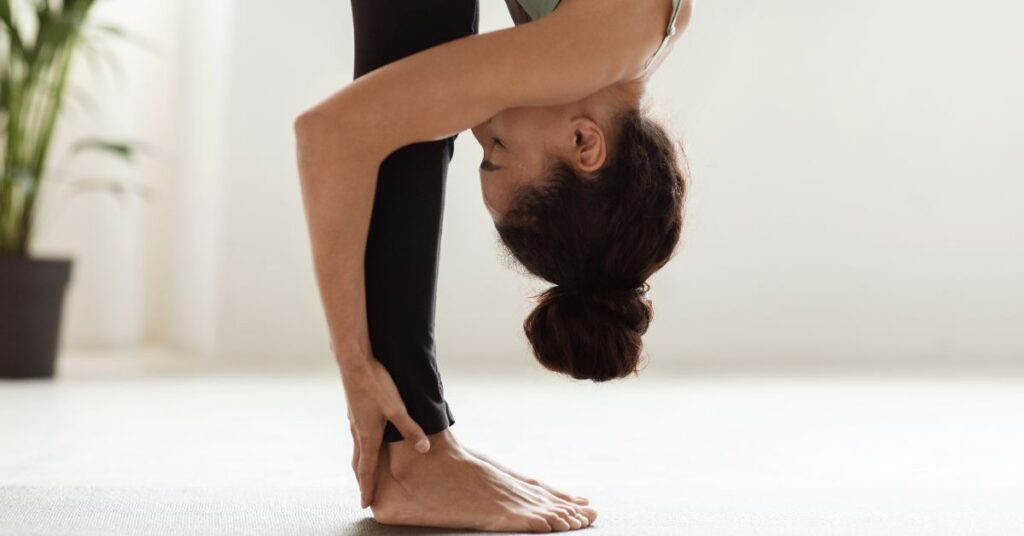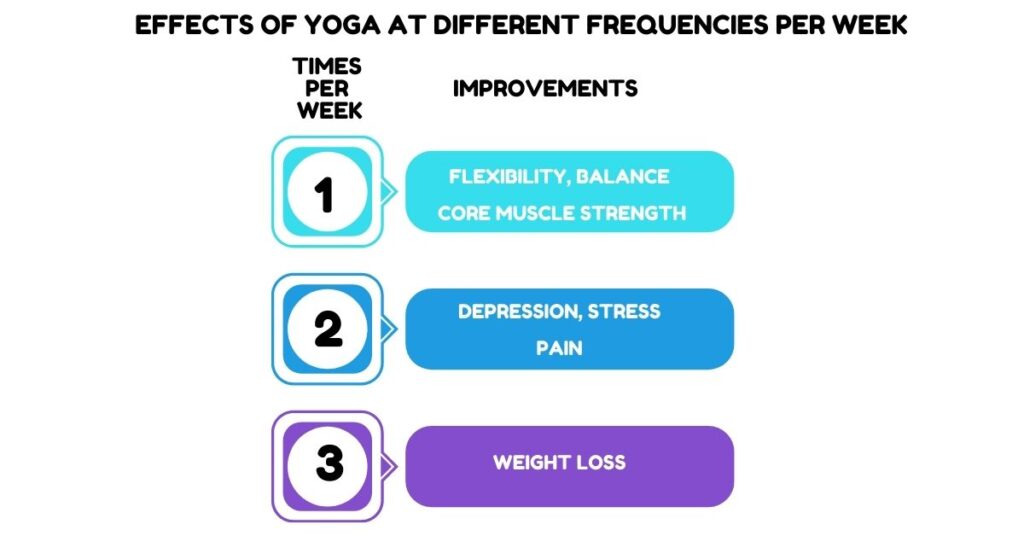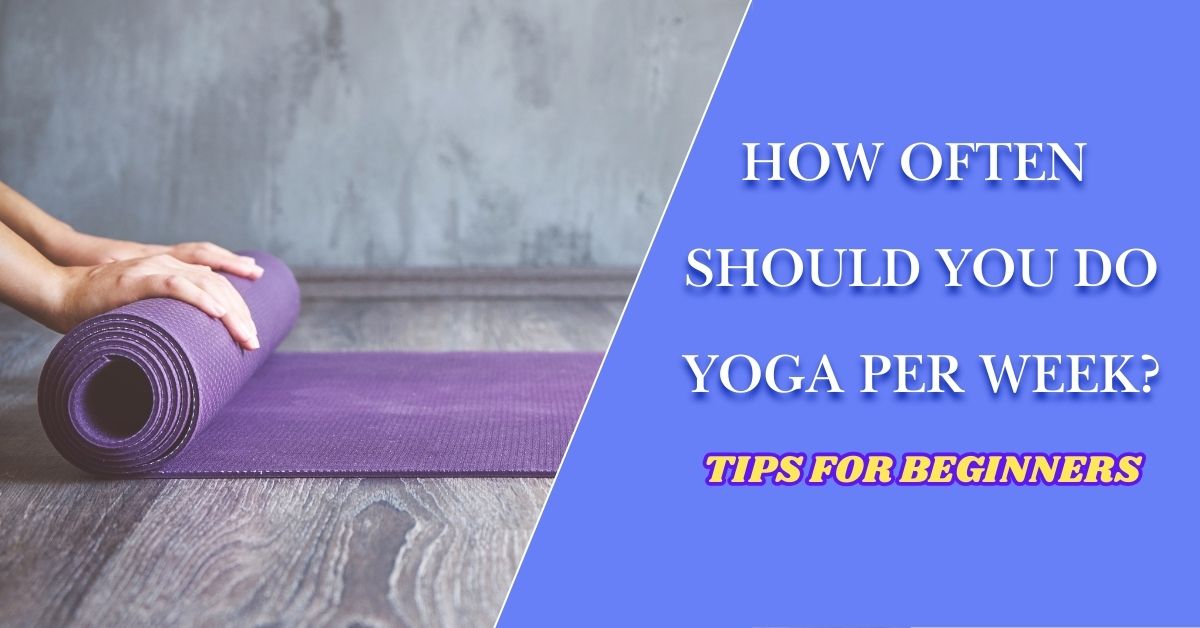How often should you do yoga? When you start out with yoga, this is a common question. Should you do yoga three times a week to feel the benefits, or is it once a week to feel the magic? Do you have to become a guru and practice every single day to feel the sweetness of it?
You want to do it right, but it also has to fit into your busy schedule. Because if you have a life besides yoga and juggling between family and work, practicing yoga everyday seems to be like an impossible dream.
In this blog, I will share my own journey with yoga. How the beginning was, how I kept myself motivated and the moment of transformation. Then, I will dive into some scientific research to find out the perfect yoga routine for your body and mind.

Starting Out: Even Once A Week Was A Challenge
I stumbled upon yoga around 2010, during a backpacking trip through India. In India, I attended an Iyengar yoga retreat for four weeks. I immersed myself in the practice which was 90 minutes, twice a day for six weeks. The Sundays were free for short trips.
It was a perfect schedule, and I felt like I was on cloud nine. I felt stronger and felt the real physical transformation of my body. But I had not yet understood the full power of yoga, which was the side of the mind. I just saw it as a gentle form of physical exercise.
After I left the retreat, it was really hard to motivate myself to practise regularly. I just practiced yoga once per week.
Getting Into A Routine: 3 Times A Week Kept Me In Good Shape

After my yoga retreat, I started a full-time job as a translator. This meant staring at your screen and sitting on a desk for endless hours. The first half year, I ignored my stiff neck and back pain and I did not do any exercise.
But these minor discomforts added up and one day the bomb exploded – I could not get out of my bed! One morning, my neck was in so much pain that I was trapped in bed for the whole day. This event was a turning point in my life. From that day on, I committed myself to doing regular exercise.
Besides swimming and running, I practiced yoga three days a week for about thirty minutes in the morning. My physical health improved dramatically, my muscle and joint pain melted away,I never had a severe stiff neck or stiff shoulders after that.
Teacher Training: 6 Times A Week Feels Great Again
In 2016, my passion for yoga did not stop and I decided to do teacher training in Italy. As in the retreat in India, I had the joy of practising yoga twice a day, six days a week for a month.
My morning started at six o’clock with a gentle ritual of morning tea. Then, the yoga class started at eight o’clock and lasted for one and a half hours. Afterward, we had a nutritious vegetarian breakfast, and the rest of the morning was dedicated to practice on your own.
In the afternoon, we had some asana classes as well as yoga physiology and philosophy. I cherished the sensation of how my body transformed―becoming more flexible and perfectly aligned. But the most striking experience was the change within. It was the first time I felt that I could meditate so well because my body was perfectly aligned. It was a revelation.
Unfortunately, after the retreat there was not much immersion in yoga because I got pregnant with my first child and felt so sick that I could hardly do any yoga.
Healing My Postnatal Back: 5 Times A Week

After my second child, severe back pain took over my life and I felt trapped again. I could not stand for long hours, nor lift heavy things – I felt very frustrated and was waning in despair.
The back is the cornerstone of the body and if this part of your body is not functioning, it will affect your whole daily life. I could not even do yoga, which I loved so much.
To seek help, I visited a chiropractor for two months. Through massaging my legs and back, he realigned my body and shifted my weight center back. When you are pregnant, your centre of gravity is shifted forward. But after childbirth, this habit is one of the causes of postnatal back pain.
After two months, my back was still in pain, but it had recovered to a level where I could start practicing yoga again. I longed for a healthy back again, so I committed myself to do yoga five times a week for one hour in the morning.
The first three weeks were hard, I needed to dig deep for motivation. But after that three weeks passed, it became really easy to do five times a week. I kept this routine for about one year, and it worked! My back grew stronger and stronger with each month and I was pain free again.
I was in seventh heaven again.
It was also during this time that I started to realise that yoga was not just a physical exercise but also a journey of the mind. I began to understand that when you look into your body, you calm yourself and prepare yourself to look deeper inside and think about your mind.
3 To 4 Times a Week: After Long Hours Of Desk Work
My current golden standard for yoga frequency in a week is three to four times a week. Whenever I work long hours at my desk, I loosen up my stiff shoulders and back with a quick 30-minute yoga session. And once a week I have a 1.5 hour yoga session with my yoga teacher. This rhythm really helps to prevent serious back or neck problems.
How Often Should You Do Yoga: Research Backed Insights
Enough about my experiences! Let’s take a look at some research results. So what does science recommend about how often you should do yoga in one week?
Practicing Yoga 1 Time Per Week: Improvement In Balance, Flexibility And Muscle Strength

How about practicing yoga once per week? According to a study of university students, even once per week of Hatha yoga is beneficial to your health1 . The following things improved:
- Balance
- Flexibility
- Core muscle strength
But it did not have an effect on BMI, body fat percentage, or heart rate. If you want to improve muscle strength, balance and flexibility, once per week seems to work. However, if you want to lose weight, the study suggests that you need to practice more than once a week.
Practicing Yoga 2 Times A Week: A Remedy For Stress And Pain

A study on university students shows that twice a week of Hatha yoga can help2. Over 8 weeks long, 12 university students who were yoga beginners attended a 60 min long yoga class twice a week. The results were quite significant:
- Stress level decreased by 11%
- Depression symptoms decreased by 25%
These results show that even two times per week can have a significant effect on your mental well being.
Another study conducted in Canada shows that two times a week of yoga helps to reduce pain3 3). 22 Women within the age range from 17 to 71 years old suffering from fibromyalgia attended a 75 min long Hatha yoga class twice a week for 8 weeks.
Fibromyalgia is a condition in which you have muscle and bone pain accompanied with symptoms like fatigue, cognitive impairment, sleep problems, feelings of anxiety, symptoms of depression, digestive issues, and physical stiffness. In patients suffering under fibromyalgia, there is an indication that the hypothalamic pituitary adrenal gland is not functioning as expected.
As a result, not as much cortisol hormone is produced, which is necessary in regulating the body’s stress response, suppressing inflammation, and regulating blood sugar. Due to low cortisol levels, patients suffer from fatigue, pain, and psychological stress. The result was that the subject’s cortisol level increased after the 8 week yoga program.
The result tells us that Hatha yoga twice a week not only helps to improve mental health, but also reduces pain. Looking at the two studies above, two times a week yoga for more than 60 minutes seems to have a significant effect on your health. It can reduce pain, improve your mental health and make you more resilient to stress.
Practicing Yoga 3 Times Per Week: Path To Effective Weight Loss

Another study conducted in Thailand suggests that three times a week helps to reduce your BMI 4. This study was on 20 young female participants between 19 and 22 years old. Their BMI ranged from 23 to 29.5 at the beginning.
The participants took part in a 12 week yoga project where they attended a 50 minutes long yoga class three times a week. The yoga style was continuous, meaning there was not so much resting time between yoga poses and it was done dynamically.
After the 12 weeks, the results showed changes in the following indices:
- BMI decreased from an average of 22.70 to 22.02
- Body fat mass decreased from an average of 29.25 to 26.37
- Muscle mass increased from an average of 25.31 to 25.83
The above result suggests that a yoga workout three times per week helps to lose weight.
Conclusion

Based on the research above, even one session per week can help maintain flexibility, improve balance and strengthen your core muscles. However, you need to practice more than once a week to manage stress, alleviate depression, and relieve pain. If you want to lose weight, try three fast-paced yoga sessions per week.
From my own experience, three to four times a week of yoga is a perfect fit into my schedule. Keep one thing in mind: how many times you practice yoga depends on your health, goal as well as lifestyle. And one last point: try to mix up your poses. If you practiced standing poses one day, try twists or upper body poses the next.
I hope this article helped you to find your own “golden path” to yoga.
How about your yoga routine? Tell us about how many times you practice yoga by commenting below.
Reference
- Csala B, Szemerszky R, Körmendi J, Köteles F, Boros S. “Is Weekly Frequency of Yoga Practice Sufficient? Physiological Effects of Hatha Yoga Among Healthy Novice Women”. Front Public Health. 2021 Oct 18;9:702793. doi: 10.3389/fpubh.2021.702793. PMID: 34733813; PMCID: PMC8559597. ↩︎
- Forseth, B., et al. (2022). “Adherence to and changes in mental and physiological health during an 8-week yoga intervention: A pilot study”. Journal of Bodywork and Movement Therapies, 30, 203–209. https://doi.org/10.1016/j.jbmt.2022.01.004 ↩︎
- Curtis, K., Osadchuk, A., & Katz, J. (2011). “An eight-week yoga intervention is associated with improvements in pain, psychological functioning and mindfulness, and changes in cortisol levels in women with fibromyalgia”. Journal of Pain Research, 4, 189–201. https://doi.org/10.2147/JPR.S22761 ↩︎
- Na Nongkhai, Marisa Poomiphak, Yamprasert, Rodsarin, Punsawad, Chuchard, Effects of Continuous Yoga on Body Composition in Obese Adolescents, Evidence-Based Complementary and Alternative Medicine, 2021, 6702767, 7 pages, 2021. https://doi.org/10.1155/2021/6702767 ↩︎


Comments